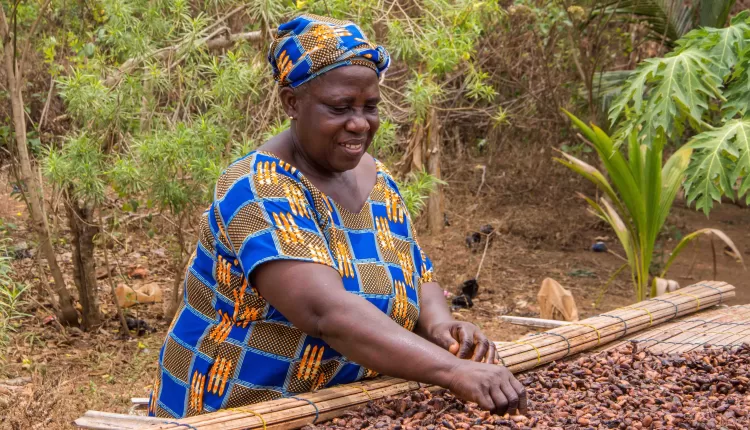For several years, there is an active international community of scholars and activists promoting a benchmark for paying a decent ‘living income’ to smallholder farmers and workers in developing countries.
While agreement has been reached on a common measurement approach, far less progress is made in defining operational strategies for closing the living income gap.
There are different reasons why smallholder farmers cannot reach living income benchmarks. This is often attributed to resource constraints – particularly of land and capital – and limited access to knowledge and information, unequal market conditions, and failures in governance regimes that limit opportunities for improving value chain efficiency or constrain land and labour productivity.
Living income gaps not only affect prospects for reaching sustainable and inclusive livelihoods but are also considered to be responsible for other socio-economic barriers that affect food and livelihood insecurity and human rights in supply chains.
Farmers’ resilience to shocks is seriously hampered when minimum living income standards cannot be reached. It is therefore important to unravel the key determinants of living incomes and to understand their dynamics.
Recent living income estimates (2022) based on rigorous studies using the Anker methodology for cocoa farming families in Ghana are pegged at $1.96 (GHC 15.28) per person per day and $298 (GHC 2,324 ) monthly for a family of five (2 adults and 3 Children) with farm size up to 4 hectares.
Although this benchmark is valuable for providing the industry a reference point to improve farm-level prices, it disguises insights into the structural requirements for lifting farmers out of poverty.
It appears rather impossible to reach the living income benchmark for many farmers with tiny plots and yield levels less than half what is used in the reference study.
Moreover, even reaching the living income benchmark represents no guarantee that farmers can satisfy livelihood standards that enable them to structurally overcome extreme poverty.
The living income agenda takes away attention from several important socio-economic realities that smallholders face:
- Smallholders receive incomes from multiple sources
Smallholder farmers are engaged in production of multiple (food and cash) crops and also gain income from non-farm work, self-employment and off-farm employment.
This diversification of income sources is a strategy for reducing risks. Improving living income is not only related to better prices for the produce, but mainly requires that farmers are able to engage in a range of different activities.
Higher yields that require more on-farm labour use are therefore less attractive since it limits smallholder opportunities for income and risk diversification.
- Expenditures for farm inputs and labour are required to generate a living income
Current definitions of living income include a nutritious diet, clean water, decent housing, education, health care and other essential needs, plus a little extra for emergencies and savings.
This implies that livelihoods of rural households are mostly considered from the consumption side. Expenditures required for generating a living income are usually made before this income is generated.
Pre-finance provisions for purchasing inputs and to reward family and wage labour should therefore be available to create reasonable prospects for reaching the living income.
- Living incomes should also include savings for asset creation
Living income strategies are strongly focused on household expenditures for guaranteeing a healthy diet and decent living conditions. Savings are included only for emergency purposes and to enable households to withstand unexpected shocks or sudden income shortfalls.
For maintaining a living income, farmers need to make a reasonable profit and require access to critical assets (for hiring land and purchasing seeds and implements) that can only be acquired with structural savings & credit mechanisms.
- Raising living incomes requires different investment strategies
Insufficient rural incomes are caused by different factors, varying from limited yields or low market prices that are caused by too small fields or heterogeneous product quality.
These underlying reasons for income shortfalls need to be addressed with specific strategies that require substantial investments in assets, training, and agricultural inputs.
- Living income constraints can only be overcome with public investments
Most strategies for reducing living income gaps focus on farm-level measures to enhance resource productivity or market-based strategies for raising prices.
Local farmers, traders and chocolate brands are mainly considered responsible for raising income. However, low prices and stagnant productivity also depend on structural conditions, such as access to roads and energy, rural extension services and market information systems.
Public investments for regional infrastructure including social services and stronger institutions (cooperatives; women self-help groups) are critical to enable farmers to overcome extreme poverty.
In summary, the current living income concept should considerably be amended and enriched to include elements that go beyond the mere description of its components. Improving smallholder labour rewards, asset creation and external infrastructure are indispensable for reaching and sustaining viable living income strategies.
Authors:
Ruerd Ruben & Priscilla Selinam Opoku
Professor, The Netherlands Development Consultant & Changemaker, Ghana
([email protected]) ([email protected])
- Enriching the Significance of Living Income - January 17, 2024
- Empowered Women Lead the Fight Against Child Labour - March 15, 2021
